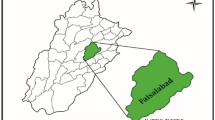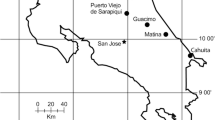Abstract
For many agricultural systems, limited data is available on abundance and diversity of insects that are not crop pests or their natural enemies. As recent studies suggest that insect abundance and diversity is declining, there is a need to quantify insect diversity within crop fields to determine what role crop fields play in maintaining diversity. In this study, alfalfa fields, almond orchards, vineyards, olive orchards, and pastures located in the San Joaquin Valley of California were sampled. Ground sweep samples were collected from all five habitats. In addition, foliar beat samples were collected from almond orchards, vineyards, and olive orchards. In total, ~ 240,000 arthropods were collected with the majority identified to family. Across crops and sampling methods, 20 arthropod orders and 202 insect families were observed. Hemiptera was the most abundant order of insect collected, representing an average of 61% of all arthropods collected. Diptera was the most diverse order of insect collected, with a total of 59 dipteran families observed across crops. Of the 202 insect families observed, 85 were observed in all 5 habitats (42%), whereas 48 families were observed in only one habitat (24%). Families observed in a single habitat were often represented by only a few individuals. Principal component analysis indicated that the communities present in the understory of vine and tree crops were more similar to each other than to the communities observed in pastures or alfalfa fields. Much of the total insect biomass belonged to a few families that included known agricultural pests. In contrast, most of the diversity was made up of families present in low to moderate abundance.










Similar content being viewed by others
References
Alomar D, González-Estévez MA, Traveset A, Lázaro A (2018) The intertwined effects of natural vegetation, local flower community, and pollinator diversity on the production of almond trees. Agric Ecosyst Environ 264:34–43
Benhadi-Marin J, Pereira JA, Barrientos JA, Bento A, Santos SAP (2011) Diversity of predaceous arthropods in the almond tree canopy in northeaster Portugal: a methodological approach. Entomol Sci 14:347–358
Canevari M, Putnam DH (2007) Managing depleted alfalfa stands: overseeding and other options. In: Summers CG, Putnam DH (eds) Irrigated alfalfa management for Mediterranean and Desert Zones. University of California Agriculture and Natural Resources, Davis
[CDFA] California Department of Food and Agriculture (2016) California almond acreage report. California Department of Food and Agriculture, Sacramento
[CDFA] California Department of Food and Agriculture (2017) California agricultural statistics review 2016–2017. California Department of Food and Agriculture, Sacramento
[CDFA] California Department of Food and Agriculture (2018a) Grape acreage report 2017 crop. California Department of Food and Agriculture, Sacramento
[CDFA] California Department of Food and Agriculture (2018b) California county agricultural commissioners’ reports crop year 2015–2016. California Department of Food and Agriculture, Sacramento
Costello MJ, Daane KM (1999) Abundance of spiders and insect predators on grapes in Central California. J Arachnol 27:531–538
Daane KM, Costello MJ (1998) Can cover crop reduce leafhopper abundance in vineyards? Calif Agricult 52:27–33
Daane KM, Hogg BN, Wilson H, Yokota GY (2018) Native grass ground covers provide multiple ecosystems services in Californian vineyards. J Appl Ecol 55:2473–2483
Fidelibus M, El-kereamy A, Haviland D, Hembree K, Zhuang G, Stewart D, Sumner DA (2018) Sample costs to establish and produce table grapes: San Joaquin Valley—South. University of California Cooperative Extension, Oakland
Forero LC, Ingram R, Davy J, Nader G, Klonsky K, Stewart D (2015) Sample costs to produce pasture: Sacramento Valley. University of California Cooperative Extension, Oakland
Gotelli NJ, Colwell RK (2001) Quantifying biodiversity: procedures and pitfalls in the measurement and comparison of species richness. Ecol Lett 4:379–391
Gurr GM, Wrateen SD, Landis DA, You M (2017) Habitat management to suppress pest populations: progress and prospects. Annu Rev Entomol 62:91–109
Hahn M, Brühl CA (2016) The secret pollinators: an overview of moth pollination with a focus on Europe and North America. Arthropod Plant Interact 10:21–28
Hallmann CA, Sorg M, Jongejans E, Siepel H, Hofland N, Schwan H, Stenmans W, Müller A, Sumser H, Hörren T, Goulson D, de Kroon H (2017) More than 75 percent decline over 27 years in total flying insect biomass in protected areas. PLoS ONE 12:e01858109
Hanson BD, Rocoroni J, Hembree KJ, Molinar R, Elmore CL (2014) Tree, vine, and soft-fruit crops. In: Fennimore SA, Bell CE (eds) Principals of weed control. California Weed Science Society, Salinas, pp 334–389
Henselek Y, Eilers EJ, Kremen C, Hendrix SD, Klein A-M (2018) Pollination requirements of almond (Prunus dulcis): combing laboratory and field experiments. J Econ Entomol 111:1006–1013
Kleijn D, Rundlöf M, Scheper J, Smith HG, Tscharntke T (2011) Does conservation on farmland contribute to halting the biodiversity decline? Trends Ecol Evol 26:474–481
Klein A-M, Brittain C, Hendrix SD, Thorp R, Williams N, Kremen C (2012) Wild pollination services to California almond rely on semi-natural habitat. J Appl Ecol 49:723–732
Klonsky K, Sibbett GS, Freeman M, Livingston P (1997) Sample costs to establish a manzanillo olive orchard and produce olives in the southern San Joaquin Valley. University of California Cooperative Extension, Oakland
Landis DA, Wratten SD, Gurr GM (2000) Habitat management to conserve natural enemies or arthropod pests in agriculture. Annu Rev Entomol 45:175–201
Larson BMH, Kevan PG, Inouye DW (2001) Flies and flowers: taxonomic diversity of anthophiles and pollinators. Can Entomol 133:439–465
Leather SR (2018) “Ecological armageddon"—more evidence for the drastic decline in insect numbers. Ann Appl Biol 172:1–3
Lichtenberg EM, Kennedy CM, Kremen C, Batáry P, Berendse F, Bommarco R, Crowder DW (2017) A global synthesis of the effects of diversified farming systems on arthropod diversity within fields and across agricultural landscapes. Glob Change Biol 23:4946–4957
McGill BJ, Etienne RS, Gray JS, Alonso D, Anderson MJ, Benecha HK, Dornelas M, Enquist BJ, Green JL, He F, Hurlbert AH, Maguarran AE, Marquet PA, Maurer BA, Ostling A, Soykan CU, Ugland KI, White EP (2007) Species abundance distributions: moving beyond single prediction theories to integration within an ecological framework. Ecol Lett 10:955–1015
Moreira X, Abdala-Roberts L, Rasmann S, Castagneyrol B, Mooney KA (2016) Plant diversity effects on insect herbivores and their natural enemies: current thinking, recent findings, and future directions. Curr Opin Insect Sci 14:1–7
Moulton JK, Wiegmann BM (2007) The phylogenetic relationships of flies in the superfamily Empidoidea (Insects: Diptera). Mol Phylogenet Evol 43:701–713
Pfister SC, Sutter L, Albrecht M, Marini S, Schirmel J, Entling MH (2017) Positive effects of local and landscape features on predator flies in European agricultural landscapes. Agric Ecosyst Environ 239:283–292
Pocock MJO, Jennings N (2008) Testing biotic indicator taxa: the sensitivity of insectivorous mammals and their prey to the intensification of lowland agriculture. J Appl Ecol 45:151–160
Ponce C, Bravo C, de León DG, Magaña M, Alonso JC (2011) Effects of organic farming on plant and arthropod communities: a case study in Mediterranean dryland cereal. Agric Ecosyst Environ 141:193–201
Poveda K, Martinez E, Kersh-Becker MF, Bonilla MA, Tscharntke T (2012) Landscape simplification and altitude affect biodiversity, herbivory and Andean potato yield. J Appl Ecol 49:513–522
Prischmann DA, James DG, Gingras SN, Snyder WE (2005) Diversity and abundance of insects and spiders on managed and unmanaged grapevines in southcentral Washington state. Pan-Pacific Entomol 81:131–144
Rader R, Bartomeus I, Garibaldi LA, Garratt MPD, Howlett BG, Winfree R, Cunningham SA, Woyciechowski M (2016) Non-bee insects are important contributors to global crop pollination. Proc Natl Acad Sci USA 113:146–151
Rieux R, Simon S, Defrance H (1999) Role of hedgerows and ground cover management on arthropod populations in pear orchards. Agric Ecosyst Environ 73:119–127
Ruano F, Lozano C, Garcia P, Peña A, Tinaut A, Pascual F, Campos M (2004) Use of arthropods for the evaluation of the olive-orchards management regimes. Agric For Entomol 6:111–120
Sáenz-Romo MG, Veas-Bernal A, Martínez-García H, Campos-Herrera RC, Ibáñez-Pascual S, Martínez-Villar E, Pérez-Moreno I, Marco-Mancebón VS (2019) Ground cover management in a Mediterranean vineyard: impact on insect abundance and diversity. Agric Ecosyst Environ 283:106571
Sánchez-Bayo F, Wyckhuys KAG (2019) Worldwide decline of the entomofauna: a review of its drivers. Biol Conserv 232:8–27
Saunders ME, Luck GW, Mayfield MM (2013) Almond orchards with living ground cover host more wild insect pollinators. J Insect Conserv 17:1011–1025
Shackelford G, Steward PR, Benton TG, Kunin WE, Potts SG, Biesmeijer JC, Sait SM (2013) Comparison of pollinators and natural enemies: a meta-analysis of landscape and local effects on abundance and richness in crops. Biol Rev 88:1002–1021
Simon S, Bouvier J-C, Debras J-F, Sauphanor B (2010) Biodiversity and pest management in orchard systems. A review. Agron Sustain Dev 30:139–152
Sisterson MS, Yacoub R, Montez G, Grafton-Cardwell EE, Groves RL (2008) Distribution and management of citrus in California: implications for management of glassy-winged sharpshooter. J Econ Entomol 101:1041–1050
Sisterson MS, Thammiraju SR, Lynn-Patterson K, Groves RL, Daane KM (2010) Epidemiology of diseases caused by Xylella fastidiosa in California: evaluation of alfalfa as a source of vectors and inocula. Plant Dis 94:827–834
Soares JBC, Costa EM, da Silva FEL, Araujo EL (2016) Insect diversity in an experimental vineyard in the state of Rio grande do norte, Brazil. Revista Caatinga 29:239–245
Ssymank A, Kearns CA, Paper T, Thompson FC (2008) Pollinating flies (Diptera): a major contributor to plant diversity and agricultural production. Trop Conserv 9:86–89
Summers CG (1998) Integrated pest management in forage alfalfa. Integr Pest Manag Rev 3:127–154
Triplehorn CA, Johnson NF (2005) Borror and Delong’s introduction to the study of insects. Brooks/Cole, Belmont
Wardhaugh CW (2015) How many species of arthropods visit flowers? Arthropod Plant Interact 9:547–565
Winter S, Bauer T, Straus P, Kratschmer S, Paredes D, Popescu D, Landa B, Guzmán G, Gómez JA, Guernion M, Zaller JG, Batáry P (2018) Effects of vegetation management intensity on biodiversity and ecosystem services in vineyards: a meta-analysis. J Appl Ecol 55:2484–2495
Yaghmour M, Haviland DR, Fichtner EJ, Sanden BL, Viveros M, Sumner DA, Stewart DE, Gutierrez CA (2016) Sample costs to establish an orchard and produce almonds: San Joaquin Valley South. University of California Cooperative Extension, Oakland
Acknowledgements
Funding for this work was from United States Department of Agriculture (USDA) Agricultural Research Service appropriated Project 2034-22000-012-00D. Mention of trade names or commercial products in this publication is solely for the purpose of providing specific information and does not imply recommendation or endorsement by the USDA. USDA is an equal opportunity employer.
Author information
Authors and Affiliations
Corresponding author
Ethics declarations
Conflict of interest
The authors declare that the they have no conflict of interest.
Ethical approval
This article does not contain any studies with human participants or vertebrate animals. All authors have approved the manuscript and agree to submission to Journal of Insect Conservation.
Additional information
Publisher's Note
Springer Nature remains neutral with regard to jurisdictional claims in published maps and institutional affiliations.
Electronic supplementary material
Below is the link to the electronic supplementary material.
Rights and permissions
About this article
Cite this article
Sisterson, M.S., Dwyer, D.P. & Uchima, S.Y. Insect diversity in vineyards, almond orchards, olive orchards, alfalfa fields, and pastures in the San Joaquin Valley of California. J Insect Conserv 24, 765–777 (2020). https://doi.org/10.1007/s10841-020-00250-2
Received:
Accepted:
Published:
Issue Date:
DOI: https://doi.org/10.1007/s10841-020-00250-2




